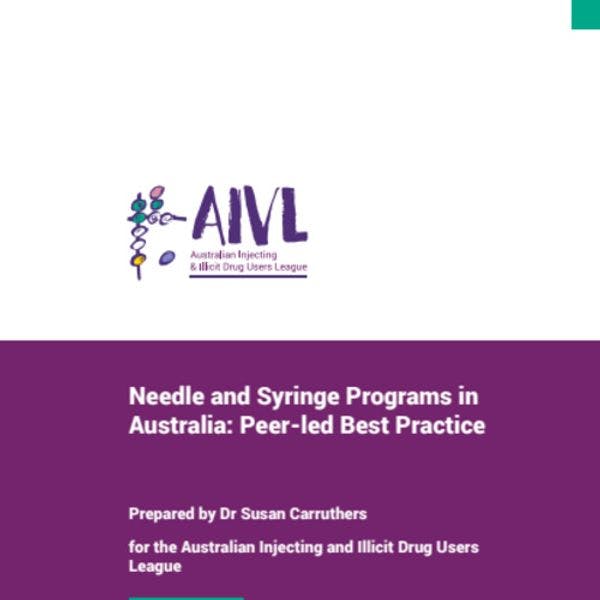Programas de agujas y jeringas en Australia: mejores prácticas dirigidas por pares
La organización AIVL destaca la importancia de los servicios de agujas y jeringas que son concebidos por las propias personas que se inyectan drogas y que responden a las necesidades de estas. Más información, en inglés, está disponible abajo.
By Dr Susan Carruthers,
National consultations undertaken by AIVL in 20171 reveal a number of systemic and service level barriers that contribute to increasing rates of sharing and reuse of injecting equipment, such as experiences of stigma and discrimination, limited and inconsistent range of injecting equipment and laws that restrict the availability of equipment.
Barriers to accessing sterile injecting equipment contribute to decisions to share injecting equipment, which latest data from the Australian Needle and Syringe Program (NSP) Survey2 illustrates has been on the rise over recent years, increasing the risk of new hepatitis C and HIV transmissions.
Australia has long been at the forefront of hepatitis C and HIV responses, yet our goals of eliminating these viruses cannot be achieved without a strong and responsive prevention system.
Outlined below are best practices for NSP service provision that are defined by and responsive to the needs of people who inject drugs. AIVL calls for these best practices to be implemented to ensure that Australia can achieve its hepatitis C and HIV elimination goals:
- Diversity of options with consistency of experience People who require NSP services should have an expectation that wherever possible and regardless of service site, a consistent range of injecting equipment is available that goes beyond basic fit packs, and that the experience is non-judgemental and creates an environment where additional health information is available when requested.
- Ensuring that all parts of Australia’s NSP system are welcoming and non-judgemental Experiences of stigma were identified as playing a role in decisions to use a particular service type or to engage with service staff. All parts of the NSP system should be focused on creating welcoming, non-judgemental environments, either through staff training or, in the case of syringe dispensing machines (SDMs), ensuring the location is not stigmatising with unnecessary surveillance.
- Ensuring consistency of equipment across all service types AIVL’s 2017 literature review on NSP service provision noted the variability of equipment availability across jurisdictions, with some types of equipment available in particular jurisdictions but not in others. Different types of injecting require different equipment, therefore a consistent range of basic equipment should be provided across all NSP service types.
- Creating an enabling environment that maximises the widest availability of injecting equipment Inconsistencies in legislation and regulation, such as the varying legality of peer distribution of injecting equipment across jurisdictions, should be addressed to ensure that these barriers to injecting equipment access are removed. Legislative amendments in the ACT and Tasmania that enable provision of injecting equipment for non-medical professionals provide positive examples of leadership.
- Position NSPs as a core part of Australia’s health system NSPs, particularly primary NSPs, need to be recognised as a core part of Australia’s health system and embedded into broader health networks in order to create service and referral pathways between NSPs and other health services. Supporting partnerships through local Primary Health Networks provides a first step towards embedding fixed site NSPs into local health systems.
- Create pathways for employment of peers and encourage peer-employment outside of primary NSPs, and ensure that peer workers are adequately supported in the workplace Findings from AIVL’s consultation demonstrate the benefits that peer workers in NSPs can provide, however this is largely restricted to primary NSPs in metropolitan areas. Creating pathways to employment for peers in other NSP service types and outside of metropolitan areas will support additional engagement in the health system by people who inject drugs as well as building of peer networks that play a key role in information dissemination. The role of people with lived experience of drug use is critical in Australia’s response to blood borne viruses because of the trust that exists within peer networks and their reach into communities of people who may not frequently engage with the health system.
- Ensuring funding allows for flexibility of service delivery Allowing for greater funding flexibility will allow NSP services to better cater for local populations, such as providing outreach services in communities with dispersed populations, establishing operating hours that align with community needs or provision of a broader range of equipment that matches the community’s pattern of usage.
- Creating greater service awareness and managing expectations Underpinning best practice relating to NSP service provision also requires awareness raising and management of expectations amongst people who inject drugs around service types and service availability. Developing and implementing peer-led best practice principles within the NSP service system will help service delivery match service expectations however wider promotion of service availability may also help increase service access and overall needle and syringe coverage.
- Creating consistency in data collection with a focus on collecting what is required Concerns over privacy and confidentiality were raised through AIVL’s 2015 National NSP Forum and by a minority of participants in these consultations. Although it is not clear if data collection has any significant impact on decisions to access injecting equipment from a particular site, a best practice approach would suggest that only data that is absolutely necessary be collected.
